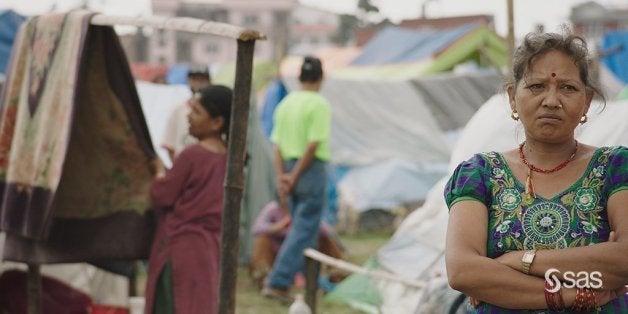
By Trent Smith, SAS
It's been six months since the second of two earthquakes shattered Nepal. Brian Kelly, Regional Emergency and Post-Crisis Advisor at IOM, and his team have been onsite since the first quake. As first responders to natural disasters, death, destruction and despair are fresh when they arrive. No shelters, save scraps from demolished homes. No medical tents, fresh water or food. Just the dusty, hollow-eyed stares of people still awakening to the loss.
More than 8.1 million people were affected by the April 25 and May 12 quakes, and more than half a million homes destroyed in towns that are no longer safe to inhabit. Against daunting odds, Kelly and his colleagues are pledged to return these people to their homes.
IOM is supporting the management of 120 sites that serve as the temporary home for almost 60,000 displaced people. IOM coordinates the distribution of water, food, medicine and other supplies. The "temporary" existence can last for months if not years, and conditions deteriorate. Crammed into tents, with visions of home obscured by smoke and rubble, it's easy to despair.
"The needs are complex," explains Kelly. "You can't solve a problem of shelter by providing a tent if the people don't have land. You can't give a commodity to someone who was a renter, because where would they put it?"
How do we get them home?
Kelly is in Sindhupalchok Province, in the town of Chautara where a relief camp has been established.
"This used to be a soccer field," he says. "Now it's an IOM office. It's got a Red Cross hospital and some UN organizations. It has a camp for people who lost their houses." He pauses, "How do we get everybody home?"
There are about 350 displaced people living in this camp, with a couple hundred more camps scattered throughout the earthquake-affected area. Conditions vary, but there is one basic truth, according to Kelly. "You don't choose to be in a camp. Every single one of these tents represents a family and a different story. Understanding their unique solutions is how you end up closing camps, get people moving home, and moving on with their lives. That's what our focus is."
Approximately 66,000 families live in Sindhupalchok municipality. Every year more and more leave the countryside seeking better education and health services. Those dreams are in ruins.
"The urban core is gone," says Kelly, guiding visitors through what remains of Chautara's vibrant market bazaar. One remaining building he points to bares a brick crack at a 45 degree angle. "That is standing rubble. It will have to come down. And 99 percent of the housing in all of the rural communities are gone, as well."
Kelly's sense of urgency is acute. A climatological clock is ticking.
"The monsoon is coming. Winter follows the monsoon and the basic needs still aren't met," a Nepali women living in the makeshift camp says.
Makeshift shelters and tents will not withstand the blinding rains and crushing winds. And the Himalayan winter is brutally cold. But there's more.
"Multi-generational poverty forces people to build in unsafe environments," warns Kelly. "No one wants that for their children, but in the absence of any other alternatives, that's what people are facing." Kelly gazes around the former soccer pitch. "Plastic sheeting and tents are not going to make it at 4,000 meters," he adds.
IOM is confident that together with its partner relief organizations, people can return to their homes and restore their dignity. But exactly how to help individuals who all have unique stories?
Recovery, brick by brick
"I spoke with a woman who was a thriving small town businesswoman. She had a shop. She also had a house that was owned on credit. Now, both are gone. Figuring out how to best help her requires data," explains Kelly.
Kelly knows short-term aid is critical. But he also hungers for a larger view of the economy and the supply chain that will advance the recovery more sustainably.
"I would much rather understand the ligaments of an economy -- the way that you connect the different pieces," he muses. For him, it's about how to be sure this small businesswoman will be able to restock her shop.
By understanding and identifying the production capacities of a country, it becomes possible to find out ways to help people without creating dependency."
"Disaster changes the whole dynamic. They used to feed their family. Now they get a sack of wheat or rice. That can lead to dependency instead of self-sufficiency."
IOM wants to ensure that local mechanisms are restarted. For that, data is needed. But raw data or data in massive spreadsheets isn't helpful when the need is urgent.
"We need to convert the data into to some kind of format that a guy like me can understand," Kelly explains. "That's not my specialty, but making the decisions based upon the information is. We can't be making hypothetical decisions that result in people suffering more."
An unexpected data source yields shelter
Three weeks after Kelly's walk through Chautara, the monsoon was underway. But there was good news.
Resourceful Nepalese had already started using salvaged scraps from broken houses. IOM was ready to assist them to safely do it to scale but needed usable data to adapt its response to the needs.
IOM turned to SAS, the analytics software provider, to find sheet metal roofing fast. IOM has been working with SAS since Typhoon Haiyan devastated the Philippines in 2013. The IOM-SAS partnership enabled the use of data to better prepare for and responds to disasters.
IOM was in need of temporary shelters for 45,000 families.
SAS, in partnership with the UN Statistics Division, was able to provide IOM with numbers and a location of where they could find material to build roofs for Nepalese affected by displacement.
"I had access to 300 million rows of global trade statistics," says I-Sah Hsieh, SAS Global Development Manager. "So I literally put him on hold and searched. Within a couple of minutes I was able to tell him that India, right next door, is the world's largest producer of what you are looking for."
I-Sah also noted that Nepal ranked seventh before the earthquake and might still have some capacity in country.
IOM immediately ordered 310,000 sheets of corrugated tin roofing. "With the UN Comtrade information, we were able to secure materials quickly and, literally, put roofs over peoples' heads," says Kelly.
Using data to modernize disaster response
I-Sah explores ways that analytics can support the humanitarian efforts of organizations like IOM and the United Nations. His work with IOM has opened his eyes to the possibility of changing disaster response on a global scale.
"Quick, reliable information is a critical, and scarce, resource immediately following a disaster," says I-Sah. "A tool like SAS Visual Analytics is particularly useful in the early phases when you don't have a full picture of the crisis. It lets the data tell the story."
"The information is easily shared with anyone that has a mobile device or Internet connection. This is especially important for people like Brian who are in the field, making life and death decisions."
IOM is convinced data can modernize disaster response around the world. With better information, victims can more rapidly become self-sufficient and re-establish their homes and lives.
Recovery, Kelly asserts, is about getting people back to where they were before.
But first IOM must make sure the camps are safe.
When IOM sets to work, it collects data on the displaced people, including demographic and family information and home town. It has data on supplies, such as clothing, bedding and other essential items. Partner organizations add information on food and water quality and availability, health symptoms and security concerns.
In the past, all that disparate data was imprisoned in individual spreadsheets. Following Typhoon Haiyan, IOM engaged with SAS to explore how to pull that data together to identify specific needs. Within minutes, the visualized data exposed severe threats in the camps that might have gone unrecognized.
Some camps had a dangerous mix of overcrowding, unsafe drinking water and solid waste disposal problems. Others had crowds of families still living in makeshift shelters. There were camps experiencing rapid growth among particularly vulnerable populations, such as pregnant women and children, over a short period. Especially alarming were camps with high concentrations of potentially life-threatening conditions, such as diarrhea, fever and skin disease, among older people.
IOM rallied this information to prioritize actions, such as sending more formula and diapers, boosting security or increasing medical resources.
Data also helps with rebuilding, and not just by locating construction materials. Mapping the earthquake's diaspora, IOM can see where residents of a town have sheltered, where the young, male residents of a certain town reside. Getting them home first can jumpstart rebuilding.
Modernizing disaster response also means understanding local economic considerations. "We must be careful that, in our drive to rebuild and restore dignity and purpose, we don't destroy the fragile foundations of the local economy," Kelly warns.
For example, there must be jobs for the men after rebuilding. And IOM has to make sure large purchases don't reduce supply so far that costs soar out of reach for locals.
"Do we need to bolster the private sector to produce jobs? Are there enough commodities to support an influx of people? We can't send them back to a place with few means to become self-sufficient." Data analysis is helping IOM make those decisions.
But IOM is only scratching the surface of what's possible. By looking at past data, analytics can make predictions. It's a sad truth that sexual assault is a completely unacceptable and yet common problem in camps. Data reveals that certain factors put camps at higher risk for rape and sexual abuse, such as amount of time spent in the camp and the number of young women and young men.
When the next disaster occurs, what can mitigate those factors and drastically reduce profound trauma on those already distressed people?
Data can anticipate the tipping point, says I-Sah. "Analytics reveals the leading predictors of camp failure, or violence against women and children. We're developing models that IOM can apply to every disaster to minimize unnecessary suffering."
On the frontlines of humanitarian crises
Some disasters to which IOM sends people like Kelly are manmade. The Syrian refugee crisis is just one example. There will always be conditions that force large groups of people from their homes.
Kelly envisions a time, though, where data and analytics are just another normal resource for IOM first responders and partner relief organizations. In the near future, standard reports will illuminate critical threats to human lives and lay the groundwork for sustained relief and recovery.
"Shortly after the precipitating event, we'll have all we need to know to reduce loss of life and establish a sense of stability for victims," says Kelly. "We'll know what they will need two weeks, four weeks, six weeks out. And we'll have the data to help us acquire the goods to meet those needs."
Kelly and IOM's world is one made up of tough choices. Better information is invaluable.
It's nearly six months after the earthquake. Kelly is at IOM's Geneva headquarters. He sighs, "If you try to help everybody, you'll help nobody. We must focus on the most vulnerable. Data helps us set those priorities."
He looks thoughtful. "We helped thousands of Nepalese families ride out the monsoon. More are returning to their homes every day. A proud people are getting their lives back. But there's much to do."
If you'd like to donate to IOM's Nepal relief efforts, please visit the IOM donation page.
